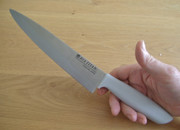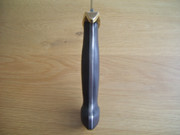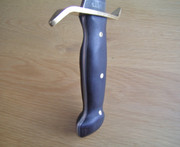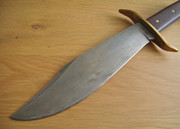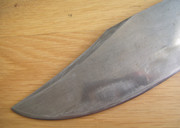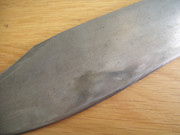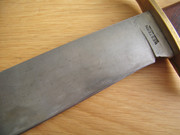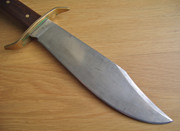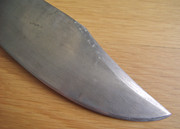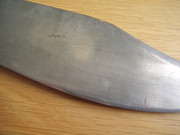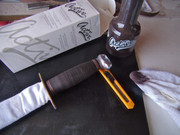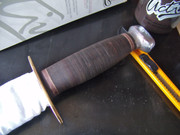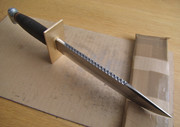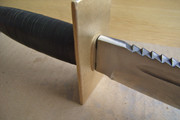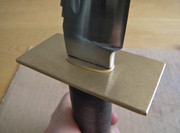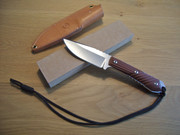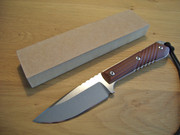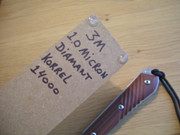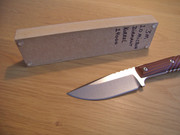The performance in our home kitchen so far is quite positive i would say, and things that stand out for me are the ultra low weight and the aggressiveness of the factory cutting edge, even though that edge is only copy paper slicing sharp.
Since one of these knives is going to be tested for some time by a real Chef who is used to truly sharp steel knives (which i sharpen for him) i want to find out if i can improve upon the factory sharpness of this material.
Beiträge von kwakster
-
-
These are the Diamond Titanium knives i received, minus one Chef knife which i already sent through to one of the admins of British knife forum Edgematters.uk, to use as he thinks best.
Soon one of the remaining new models is going to be used for a while by a professional sous-Chef in a busy restaurant kitchen, and his report will be written down later on in this thread.One santoku is already in use in our own kitchen & i use it for sharpening practice.
The text on the blade is already fading due to handling, but to me that doesn't matter.The still new & unused Santoku model:
Specs:
Overall length: 32,1 cm (12.64 inch)
Blade length: 18,7 cm (7.36 inch)
Blade thickness: 1,51 mm
Blade material: titanium alloy (48 HRC) with diamond particles, ceramic particles, and silver.
Handle material: Plastic
Weight: 84 gramsThe still new & unused Chef knife:
Specs:
Overall length: 35,0 cm (13.78 inch)
Blade length: 21,5 cm (8.46 inch)
Blade thickness: 1,78 mm
Blade material: titanium alloy (48 HRC) with diamond particles, ceramic particles, and silver.
Handle material: Plastic
Weight: 94 grams -
In the past i did 2 reviews on different Forever kitchen knives, 1 x ceramic, and 1 x titanium hybrid, both for myself and forum members to enjoy on various international knife forums.
A few weeks ago i decided to send the links to those reviews to Forever head quarters in Japan to see if i would get a reaction or not.
To my surprise i was contacted a few days later by a friendly Englishman, who told me that they had read my reviews with interest and we got to talk a bit about their products.Well, to make a long story even longer he offered to send me several Forever knives as samples and told me that i could use any of them how i'd think best, and that he hoped this would be somehow beneficial for them as a company (Forever is still a virtual unknown in the Netherlands and no shops carry their knives.)
Just before my hodliday i received the package, and in it were several Diamond Titanium knives (as well as some ceramic cutlery items, but this thread is solely about the Diamond Titanium models)
These pics i've taken from the internet:
-
Since the brass guard was a bit loose, i'm experimenting to find out if shimming it with a few small pieces of brass sheet is a viable option.
While it works very well to immobilize the guard 100 % even during maximum force chopping (tested the knife again in the woods yesterday), the shims need to be a bit smaller to be totally invisible.The 1095 Cro-Van blade steel also holds up well; after taking down several thin trees / thick saplings (think upper arm size) the edge can still shave the hair from my leg.
And this is with a 400 grit wet & dry SiC finish deburred with 1.0 micron diamond compound on MDF. -
-
-
-
The knife as it looks at this moment.
I made the guard a bit smaller, rounded the edges, then sanded & polished the brass a bit on a felt wheel with some green compound.
Glued it back in place with 2-component epoxy, then glued all the washers together on the tang and put the pommel back on with some Teflon tape on the threaded tang end. -
Currently busy making the new guard from a flat piece of brass i had lying around from a previous project.
The center hole that was already there was enlarged with a file to fit this knife, the rough outer shape was cut out with a small hacksaw, the result was ovalized on a normal bench grinder, after which the outer edge was ground square on the Tormek.More testing is needed to decide upon the final size & shape of the guard, so it's likely there will be changes in the near future.
The old guard was reshaped & reused as a cover plate on top of the new guard, but i still have to fit things a bit better.
Put the knife together temporarily for the pics. -
-
Yesterday i got the chance to test the knife again in the Veluwe nature reserve near Kootwijk, this time with the somewhat thinned out blade & an apex that fitted the 30 degree slot in my Tormek WM200 AngleMaster almost perfectly.
The area has a lot of walking trails, and the knife was used for the clearing of overgrowth etc.
In short: it performed very well in that role & with the thinner edge angle.When i left home the edge could just whittle a chest hair towards the hairpoint (more like slicing it diagonally, so no long thin curls), and after chopping through quite a bit of green branches varying in thickness from pencil-size to that of a grown man's upper arm as well as the small fallen tree in the pictures the edge could still shave the hair on the back of my hand on skin level.
Not quite as easy as before, but it could be done.
Also the weight of the knife together with the full convex blade shape made the knife an excellent chopper that bit deep without ever getting stuck: the wood had no grip on the blade whatsoever.
Wristsize green branches would take 1 chop, while upper arm thick ones took 3 to 4 chops.
The knife also performed well on thinner stuff like twigs and bramble shoots: 1 light chop without feeling any resistance.
I'm sure that a thin lightweight machete would do better in the last category, but the knife was no slouch either.There were also some negatives:
- The current "guard" is much too small to guard anything, and it's more a pointy nuisance than anything else.
- The leather handle is thicker in front and tapers towards the pommel, so when chopping wood your hand naturally shifts to the very end of the handle.
Although this position works very well for harder chops on for instance the small tree in the pictures, the current handle shape is not the best for snap cuts, like you would mostly use on anything thinner.Both of these things i hope to solve in the coming weeks.
A few impressions of the sand drift that forms the center of the wooded area:
-
Refined a bit more with 400 grit.
There are still a few faint scratches visible from the 240 grit, but before i proceed with finishing i first want to find out if the current edge angle of +/- 30 degrees inclusive holds up in actual use.
Next step will be to remove the burr on a hard leather strop with 1.0 micron diamond paste and to grind off the slight protrusion on the heel, then hopefully somewhere in the coming week do a bit of chopping in the woods. -
They are similar, but not the same.
There are differences in base materials, in weight, and in the hardness of the surfaces.At this point in time i have no hands-on experience with MDF for this particular method of motorized sharpening (only for hand strops), but a member of British Blades passed on a warning to me that he received from an English company specializing in polishing equipment, that in the professional world home-made MDF Wheels are considered too dangerous to use.
It seems that they can come apart suddenly due to the centrifugal forces most benchgrinders can create. -
See Page 1, Post 8
-
This special version of the Spyderco Paramilitary 2 in CPM-M4 steel & carbon fiber is in use with a Dutch knife forum member.
A small fraction of the tip had broken off and the apex sustained some damage (see pic 3).
This is how the knife looked before sharpening:
First i ground the old apex flat on the Tormek Blackstone until all damage in the apex was gone & there was a new point.
Then i made a new edge with 15 micron diamond compound on a Paper Wheel, which was then refined with 6, 3, and 1 micron diamond compound on dedicated Paper Wheels to a full mirror.
The new edge measures 30 degrees inclusive and is hairwhittling sharp.
After sharpening:
-
Refined one step further with 240 grit wet & dry.
I covered the blade again with waterproof marker grid lines to help me see where exactly i'm removing steel.During the sharpening movement from the back towards the apex i gradually lighten the pressure to as light as a feather, so the area that forms the actual apex gets refined almost without pressure (literally a fraction of the weight of the knife)
This to avoid enlarging both the current edge angle & the existing burr, something that is real easy to do with even a fraction too much sharpening pressure on that area.
I also check the edge every now & then with my Tormek angle gauge (also in the pictures), as even though the edge is convex, the gauge would show any dimensional changes immediately.The knife as it looks at the moment:
-
A link to some scientific work on Nano-Oil: https://link.springer.com/article/10.1007/s12541-012-0013-7
-
MDF strops are cheap & easy to make, they already have a perfectly flat surface, the material itself works very well as a substrate for fine diamond or CBN compounds (the only 2 abrasives which will actually cut & shape vanadium carbides), and for me the most important feature: MDF is noticeably harder than leather, so there is much less chance of rounding the apex of your edge.
-
This strop is what i give to customers who regularly send or bring me a CRK knife for sharpening and some TLC, so they can maintain & keep the appearance of their new edge themselves for some time at home.
It's a new & cut-to-size piece of clean MDF coated with a thin layer of 1.0 micron (+/- 14000 grit) mono-diamond compound made by 3M, and i put self-adhesive rubber bumpers (also made by 3M) on the bottom.
These make the strop non-slip plus they elevate the working surface a bit which makes the strop more convenient to use on a table (more room for your hands)The Nyala used as a prop for the pictures was recently reprofiled (from 35-40 degrees inclusive to an even 30 degrees inclusive) & sharpened (with 15 micron diamond compound on a Paper Wheel) and will be picked up by it's owner somewhere in the coming weeks.
BTW: it's main purpose is to cut oranges, about 5 each day,

-
As the knife seemed to perform just fine chopping wood with an edge of +/- 35 degrees inclusive i decided to grind the blade a bit thinner with a new edge angle of +/- 30 degrees inclusive, according to the motto: as thin as possible, but thick enough.
Most thinning was done on the belt grinder, after which i proceeded on the piece of previously used grit 180 wet & dry SiC paper on top of the glossy magazine.Due to the waterproof black marker lines on both sides of the blade as well as on the edge apex i could see quite well where the machine removed the steel (up to just before the actual edge area), after which i continued grinding manually on the grit 180 SiC paper to let the sides come together in a new apex (with a slight burr)
Before thinning on the belt sander, still with the black marker stripes on the blade:
After thinning on the belt sander (first with grit 100, then grit 120), with the edge area still black from the marker.
Although the belts have 2 coats of WD40 oil for cooling during grinding, and i dunk the blade into a bucket of water for extra cooling in between passes, the blade is getting progressively thinner, so the chances of overheating the newly forming edge area would still increase if i just ground up to a burr with the belt sander.
This method avoids not only the overheating part, but also the forming of a thick burr from the grit 120 belt due to which quality steel would be wasted needlessly.
I also use very little pressure on the belt (about the weight of the knife itself) and let the machine do the work.After hand grinding on grit 180 SiC paper, where the edge area now has been blended in with the sides of the blade.
The black marker is gone and the new apex fits almost perfectly into the 30 degrees slot of my Tormek WM200 AngleGuide.While difficult to photograph, the visible burr over the entire length of the edge shows that there is now a complete apex, a tell tale sign that grinding with grit 180 is done.
Soon some further refining steps with grit 240 and grit 400 will follow.




